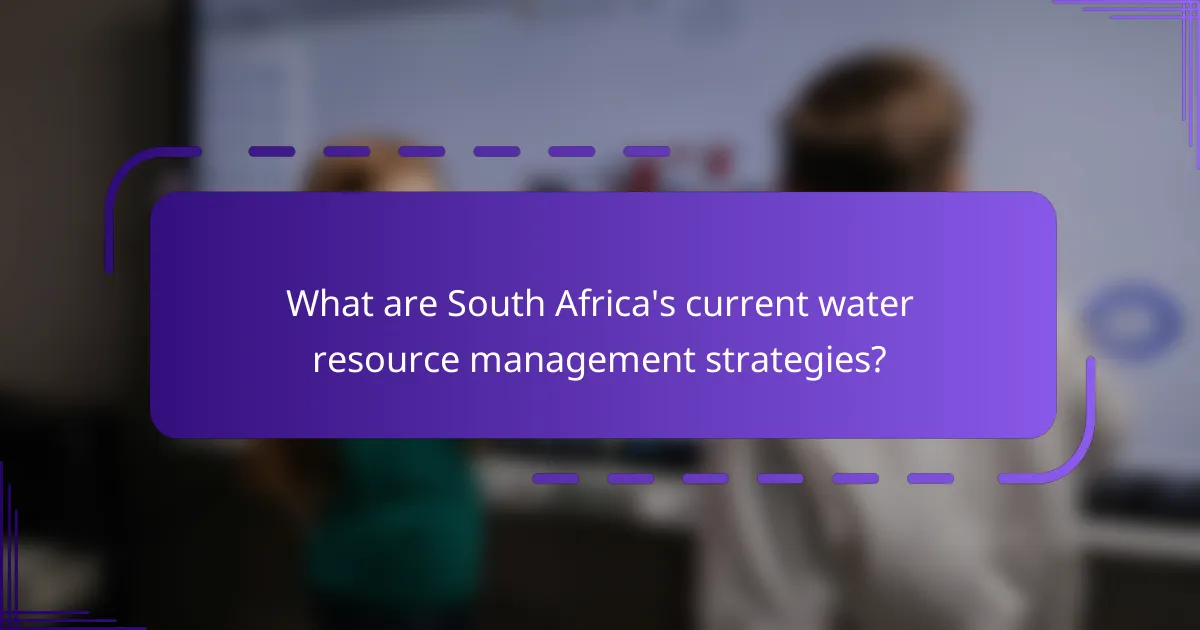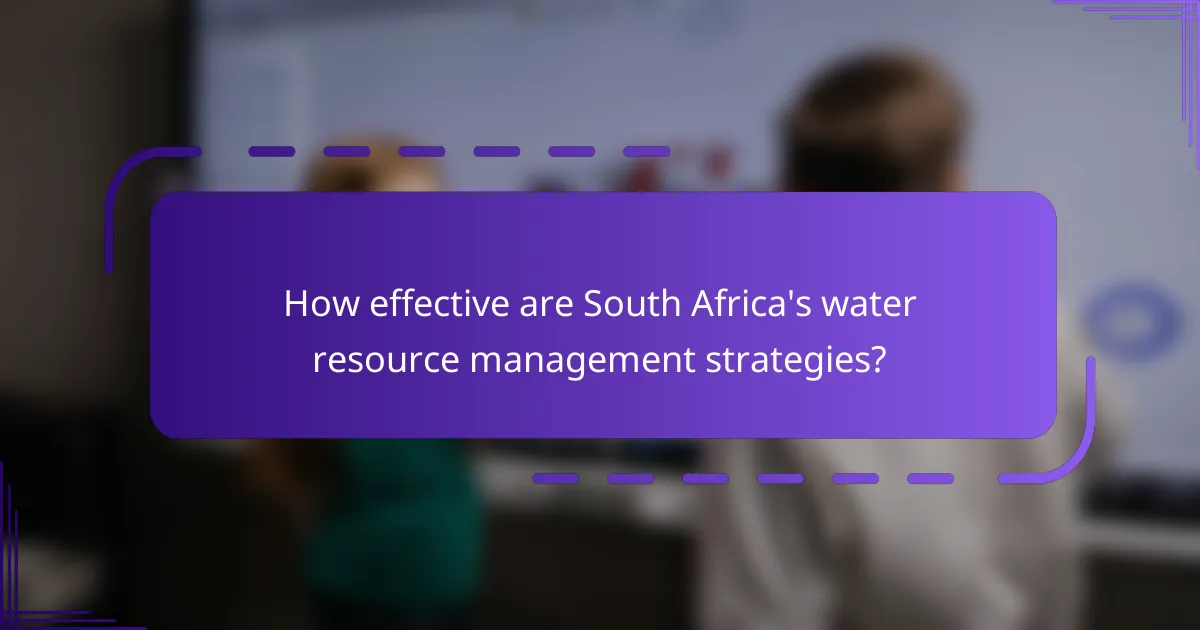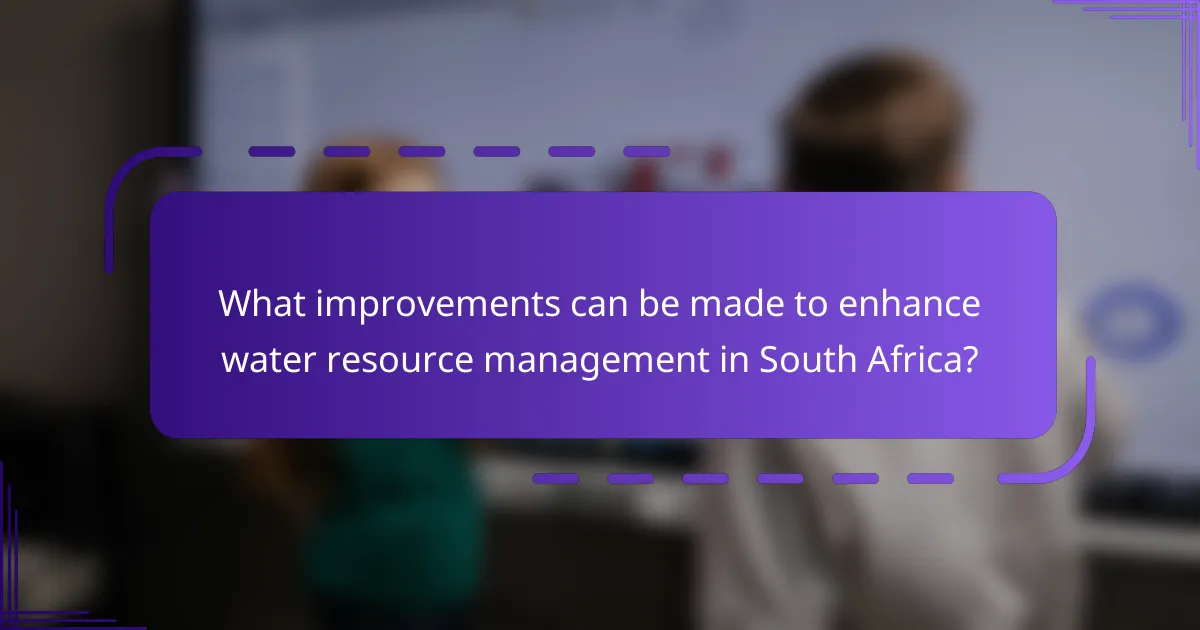South Africa’s water resource management strategies primarily encompass integrated water resource management (IWRM) and water conservation initiatives, aimed at addressing water scarcity and improving water quality. The National Water Act of 1998 serves as the foundational framework for these strategies, promoting equitable distribution and sustainable management of water resources. Despite their establishment, challenges such as aging infrastructure, climate variability, and water loss due to leaks persist. The article evaluates the effectiveness of these strategies and explores potential improvements, including investments in infrastructure, advanced treatment technologies, and enhanced monitoring systems to ensure better management and equitable access to water across communities.

What are South Africa’s current water resource management strategies?
South Africa’s current water resource management strategies include integrated water resource management (IWRM) and water conservation initiatives. IWRM focuses on the coordinated development and management of water, land, and related resources. This approach aims to maximize economic and social welfare without compromising the sustainability of ecosystems. Water conservation initiatives promote efficient water use and reduce waste across various sectors. The National Water Act of 1998 underpins these strategies, establishing a framework for equitable water distribution and sustainable management. Additionally, the country implements various programs to address water quality and pollution control, ensuring safe drinking water access. These strategies are essential in tackling the challenges posed by water scarcity and climate change.
How are these strategies developed and implemented?
Strategies for water resource management in South Africa are developed through a collaborative process involving multiple stakeholders. This includes government agencies, local communities, and environmental organizations. The development phase typically starts with data collection and analysis of current water resources. Stakeholders assess the existing challenges and opportunities in water management.
Implementation follows a structured plan that prioritizes actions based on urgency and feasibility. This often involves pilot projects to test strategies on a smaller scale. Monitoring and evaluation mechanisms are established to track progress and effectiveness. Adjustments are made based on feedback and data collected during the implementation phase.
The National Water Act of 1998 provides a legal framework guiding these strategies. It emphasizes sustainable use and equitable access to water resources.
What governmental bodies are involved in water resource management?
The governmental bodies involved in water resource management in South Africa include the Department of Water and Sanitation (DWS) and various catchment management agencies. The DWS is responsible for national policy formulation and regulation of water resources. It oversees water supply and sanitation services. Catchment management agencies operate at regional levels to manage water resources effectively. They implement local strategies and ensure sustainable use of water. Other entities, such as municipalities, also play a role in managing local water resources. These bodies work together to address water scarcity and quality issues across the country.
What stakeholder engagement processes are utilized?
Stakeholder engagement processes utilized in South Africa’s water resource management include public consultations, collaborative governance, and stakeholder forums. Public consultations allow for community input on water policies and projects. Collaborative governance involves partnerships between government, private sector, and civil society. Stakeholder forums provide a platform for ongoing dialogue and information sharing. These processes aim to enhance transparency and inclusivity in decision-making. Evidence shows that effective stakeholder engagement leads to better resource management outcomes and increased trust among communities.
What challenges does South Africa face in water resource management?
South Africa faces significant challenges in water resource management. Water scarcity is a major issue, with many regions experiencing prolonged droughts. The country has a high level of variability in rainfall, leading to inconsistent water supply. Additionally, the aging infrastructure contributes to water losses through leaks and inefficiencies. Pollution from industrial and agricultural activities further compromises water quality. Socioeconomic factors, such as poverty and inequality, limit access to clean water for many communities. Climate change exacerbates these challenges by altering weather patterns. Effective governance and policies are often lacking, hindering coordinated management efforts. These factors collectively impede sustainable water resource management in South Africa.
How do climate change and variability impact water resources?
Climate change and variability significantly impact water resources by altering precipitation patterns and increasing evaporation rates. These changes lead to more frequent droughts and floods. For instance, the Intergovernmental Panel on Climate Change (IPCC) reports that many regions are experiencing shifts in seasonal rainfall. This can result in reduced water availability in some areas while causing excess water in others. Additionally, higher temperatures can increase evaporation from reservoirs and soil, further diminishing water supplies. In South Africa, these effects are particularly pronounced, with the country facing severe water scarcity challenges. Studies indicate that climate change could reduce river flow by up to 30% in certain regions by 2050. Such impacts necessitate urgent adaptations in water resource management strategies.
What are the socio-economic factors affecting water management?
Socio-economic factors affecting water management include population growth, economic development, and income distribution. Population growth increases demand for water resources. Economic development often leads to industrial water use, impacting availability. Income distribution affects access to clean water. Wealthier communities typically have better infrastructure. Conversely, poorer areas may face water scarcity. Urbanization also strains existing water systems. Climate change exacerbates these issues, influencing water availability. Studies show that socio-economic disparities lead to unequal water access, highlighting the need for targeted policies.

How effective are South Africa’s water resource management strategies?
South Africa’s water resource management strategies are moderately effective. These strategies aim to address water scarcity and improve water quality. The National Water Act of 1998 established a framework for sustainable water management. Despite this, challenges remain, such as aging infrastructure and climate variability. According to the Department of Water and Sanitation, approximately 17% of South Africa’s water is lost due to leaks. The country has implemented various programs to enhance efficiency and conservation. However, ongoing issues with equitable access persist. Overall, while strategies exist, their effectiveness is hindered by practical implementation challenges.
What metrics are used to evaluate effectiveness?
Metrics used to evaluate effectiveness in South Africa’s water resource management strategies include water quality indicators, water availability assessments, and user satisfaction surveys. Water quality indicators measure parameters such as chemical composition and biological health. Water availability assessments evaluate the volume of water resources against demand. User satisfaction surveys gather feedback from stakeholders on the management strategies. These metrics provide a comprehensive view of the effectiveness of water management practices.
How is water quality assessed within these strategies?
Water quality is assessed through various monitoring and evaluation techniques in South Africa’s water resource management strategies. These techniques include physical, chemical, and biological assessments of water sources. Regular sampling of water is conducted to measure parameters such as pH, turbidity, and contaminant levels. Advanced technologies like remote sensing and data analytics are employed for real-time monitoring. The Department of Water and Sanitation oversees compliance with national water quality standards. Reports and assessments are published to inform stakeholders and guide policy decisions. This systematic approach ensures that water quality remains within safe limits for human consumption and ecological health.
What indicators measure water availability and distribution?
Indicators that measure water availability and distribution include precipitation levels, river flow rates, and groundwater levels. Precipitation levels indicate the amount of water entering a region. River flow rates measure the volume of water moving through rivers, which affects surface water availability. Groundwater levels reflect the amount of water stored underground, crucial for drought conditions. Additionally, water quality indicators, such as pollutant levels, assess the usability of available water. Geographic distribution of water resources across regions also highlights disparities in access. These indicators collectively inform water management strategies and policies.
What successes have been achieved through these strategies?
South Africa’s water resource management strategies have achieved significant successes. These strategies have led to improved water quality in several major rivers. For example, the rehabilitation of the Vaal River has resulted in a 30% reduction in pollution levels since 2010. Additionally, the implementation of water conservation measures has increased water use efficiency by 15% across various sectors. Another success is the establishment of community-based water management programs. These programs have empowered local communities, resulting in enhanced participation in decision-making processes. Furthermore, the government has invested in infrastructure improvements. This has increased access to clean water for millions, with 95% of urban areas now having reliable water supply.
Which regions have seen improvements in water management?
South Africa has seen improvements in water management in several regions. The Western Cape has implemented advanced irrigation techniques. These techniques have increased agricultural efficiency and reduced water wastage. The Eastern Cape has adopted rainwater harvesting systems. This has enhanced local water supply during drought conditions. Gauteng has focused on water recycling initiatives. These initiatives have significantly reduced demand on freshwater resources. The implementation of the National Water Resource Strategy has also contributed to these improvements. Overall, these regions demonstrate effective strategies in managing water resources sustainably.
How do these successes contribute to sustainable development?
Successes in South Africa’s water resource management contribute to sustainable development by ensuring efficient water use and conservation. Effective strategies reduce water wastage and enhance availability for future generations. Improved access to clean water supports public health and economic growth. Sustainable practices also protect ecosystems, promoting biodiversity. Research indicates that integrated water management can increase agricultural productivity while minimizing environmental impact. These successes align with the United Nations Sustainable Development Goals, particularly Goal 6, which aims for clean water and sanitation for all. By fostering resilience against climate change, these strategies ensure long-term sustainability in water resources.

What improvements can be made to enhance water resource management in South Africa?
Improvements to enhance water resource management in South Africa include increasing investment in infrastructure. Upgrading aging water supply systems can reduce losses from leaks. Implementing advanced water treatment technologies can improve water quality. Promoting water conservation practices among citizens can lower consumption rates. Enhancing data collection and monitoring systems allows for better management decisions. Strengthening policies for equitable water distribution ensures all communities have access. Encouraging public-private partnerships can foster innovation in water management solutions. These strategies align with South Africa’s National Water Resources Strategy, which emphasizes sustainable management and conservation.
How can technology play a role in improving water management?
Technology can significantly enhance water management by enabling efficient monitoring and distribution. Smart sensors can provide real-time data on water quality and usage. This data helps in identifying leaks and reducing waste. Geographic Information Systems (GIS) can map water resources and optimize distribution networks. Drones can survey large areas to assess water bodies and detect pollution. Advanced modeling software can predict water demand and supply trends. Mobile applications can facilitate user engagement in water conservation efforts. According to the World Bank, implementing technology can lead to a 30% increase in water efficiency. These advancements contribute to sustainable water management practices.
What innovations are currently being explored or implemented?
Innovations currently being explored in South Africa’s water resource management include smart water metering technology. This technology allows for real-time monitoring of water usage. It helps identify leaks and reduce wastage. Another innovation is the use of rainwater harvesting systems. These systems capture and store rainwater for later use. Additionally, desalination plants are being considered to provide alternative water sources. Water recycling and reuse technologies are also being implemented in various municipalities. These innovations aim to enhance water efficiency and sustainability. Implementing these technologies can significantly improve water resource management in the region.
How can data analytics enhance decision-making in water management?
Data analytics enhances decision-making in water management by providing actionable insights from large datasets. It allows for real-time monitoring of water quality and usage patterns. This leads to more informed resource allocation and usage efficiency. Predictive analytics can forecast water demand and supply, aiding in planning. Data-driven strategies can identify leakages and reduce wastage. According to the World Bank, effective data analytics can improve water management efficiency by up to 30%. This ultimately supports sustainable practices and better regulatory compliance in water management.
What best practices can be adopted from other countries?
Best practices that can be adopted from other countries include integrated water resource management (IWRM) approaches. Countries like Australia have implemented IWRM to balance water supply and demand effectively. They utilize advanced technologies for water conservation and rainwater harvesting. The Netherlands employs innovative flood management techniques, including the construction of water plazas. Singapore has developed a comprehensive water recycling system, known as NEWater, to enhance water security. These practices demonstrate successful strategies for sustainable water management. Implementing similar strategies could enhance South Africa’s water resource management.
Which international case studies are relevant to South Africa’s context?
International case studies relevant to South Africa’s water resource management include the Netherlands’ integrated water management approach. This model emphasizes collaboration between various stakeholders. The Netherlands has a strong focus on flood management and sustainable water use.
Another relevant case is Australia’s water reform initiatives. Australia implemented a market-based approach to water allocation and usage. This has improved water efficiency and conservation in agriculture.
Additionally, Israel’s water recycling and desalination technologies are notable. Israel has developed advanced methods for water reuse. This has significantly enhanced its water supply in arid regions.
These case studies provide valuable insights and best practices for South Africa’s unique challenges in water resource management.
How can lessons learned from these cases be applied locally?
Lessons learned from these cases can be applied locally by adopting best practices in water resource management. Local governments can implement strategies that have proven effective in similar contexts. For example, integrating community involvement in decision-making enhances accountability. Data-driven approaches can optimize resource allocation based on specific local needs. Training programs for local officials can disseminate knowledge about successful techniques. Monitoring and evaluation frameworks can ensure continuous improvement in practices. Collaboration with stakeholders fosters innovative solutions tailored to local challenges. Case studies from South Africa demonstrate that these methods lead to sustainable water management outcomes.
What practical steps can stakeholders take to improve water resource management?
Stakeholders can improve water resource management by implementing integrated water resource management (IWRM) practices. IWRM promotes coordinated development and management of water, land, and related resources. This approach helps maximize economic and social welfare without compromising sustainability.
Stakeholders should engage in regular data collection and monitoring of water resources. Accurate data informs decision-making and policy development. Collaboration among government, private sector, and communities is essential for effective management.
Investment in infrastructure for water storage and distribution enhances efficiency. For example, improving dam capacity can prevent water shortages during droughts. Stakeholders should also promote water conservation practices among households and industries. This can significantly reduce demand and ensure sustainable use of water resources.
Educational programs can raise awareness about water issues and best practices. Empowering communities to participate in water management fosters local stewardship. Lastly, stakeholders should establish clear policies and regulations that support sustainable water use. These measures collectively contribute to improved water resource management in South Africa.
The main entity of the article is South Africa’s water resource management strategies. The article evaluates the effectiveness of these strategies, which include integrated water resource management (IWRM) and water conservation initiatives, supported by the National Water Act of 1998. It discusses the development and implementation processes involving multiple stakeholders, the challenges posed by water scarcity and climate change, and the socio-economic factors affecting water access. The article also highlights successes achieved in water quality improvement, regional advancements, and the role of technology and data analytics in enhancing decision-making. Lastly, it outlines potential improvements and best practices that can be adopted from international case studies to further enhance water management in South Africa.